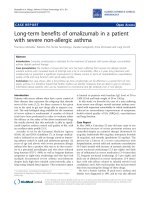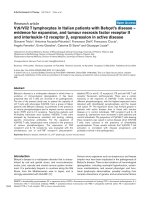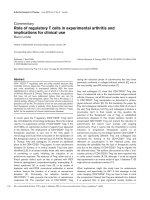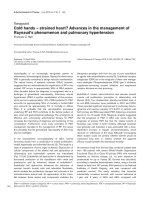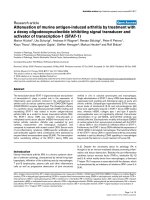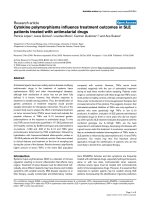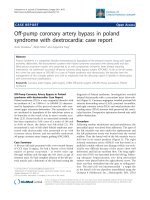Báo cáo y học: " γ δ Vγ9/Vδ2 T lymphocytes in Italian patients with Behçet’s disease – evidence for expansion, and tumour necrosis factor receptor II and interleukin-12 receptor β1 expression in active disease" pptx
Bạn đang xem bản rút gọn của tài liệu. Xem và tải ngay bản đầy đủ của tài liệu tại đây (520.78 KB, 7 trang )
R262
Introduction
Behçet’s disease is a multisystem disorder that is charac-
terized by oral and genital ulcers, and mucocutaneous,
ocular, joint, vascular and central nervous system involve-
ment. It is particularly frequent in countries along the Silk
Route, from the Mediterranean area to Japan, and is
strongly associated with HLA-B51 [1].
Various micro-organisms such as streptococci and herpes
simplex virus have been implicated in the pathogenesis of
Behçet’s disease. There is also evidence of immunological
dysregulation, including neutrophil hyperfunction, autoim-
mune manifestations, and several phenotypic and func-
tional lymphocyte abnormalities, possibly resulting from
complex interactions of genetic and environmental factors
DMAPP = dimethylallyl pyrophosphate; EF = expansion factor; FACS = fluorescence activated cell sorting; FITC = fluorescein isothiocyanate; IL =
interleukin; mAb = monoclonal antibody; PBMC = peripheral blood mononuclear cell; PBS = phosphate buffered saline; PE = phycoerythrin-
labelled; TCR = T-cell receptor; TNF = tumour necrosis factor.
Arthritis Research & Therapy Vol 5 No 5 Triolo et al.
Research article
V
γγ
9/V
δδ
2 T lymphocytes in Italian patients with Behçet’s disease –
evidence for expansion, and tumour necrosis factor receptor II
and interleukin-12 receptor
ββ
1
expression in active disease
Giovanni Triolo
1
, Antonina Accardo-Palumbo
2
, Francesco Dieli
2
, Francesco Ciccia
1
,
Angelo Ferrante
1
, Ennio Giardina
1
, Caterina Di Sano
2
and Giuseppe Licata
3
1Department of Internal Medicine, Section of Rheumatology & Clinical Immunology, University of Palermo, Palermo, Italy
2
Department of BioPathology, Section of General Pathology, University of Palermo, Palermo, Italy
3
Department of Internal Medicine, Division of Internal Medicine, University of Palermo, Palermo, Italy
Correspondence: Giovanni Triolo (e-mail: )
Received: 14 Nov 2002 Revisions requested: 10 Feb 2003 Revisions received: 10 Apr 2003 Accepted: 15 May 2003 Published: 30 Jun 2003
Arthritis Res Ther 2003, 5:R262-R268 (DOI 10.1186/ar785)
© 2003 Triolo et al., licensee BioMed Central Ltd (Print ISSN 1478-6354; Online ISSN 1478-6362). This is an Open Access article: verbatim
copying and redistribution of this article are permitted in all media for any purpose, provided this notice is preserved along with the article's original
URL.
Abstract
Behçet’s disease is a multisystem disease in which there is
evidence of immunological dysregulation. It has been
proposed that γ/δ T cells are involved in its pathogenesis.
The aim of the present study was to assess the capacity of
γ/δ T cells with phenotype Vγ9/Vδ2, from a group of Italian
patients with Behçet’s disease, to proliferate in the presence
of various phosphoantigens and to express tumour necrosis
factor (TNF) and IL-12 receptors. Twenty-five patients and
45 healthy individuals were studied. Vγ9/Vδ2 T cells were
analyzed by fluorescence activated cell sorting, utilizing
specific monoclonal antibodies. For the expansion of
Vγ9/Vδ2 T cells, lymphocytes were cultured in the presence
of various phosphoantigens. The expression of TNF
receptor II and IL-12 receptor β
1
was evaluated with the
simultaneous use of anti-TNF receptor II phycoerythrin-
labelled (PE) or anti-IL-12 receptor β
1
PE and anti-Vδ2 T-cell
receptor fluorescein isothiocyanate. There was a certain
hierarchy in the response of Vγ9/Vδ2 T cells toward the
different phosphoantigens, with the highest expansion factor
obtained with dimethylallyl pyrophosphate and the lowest
with xylose 1P. The expansion factor was fivefold greater in
patients with active disease than in those with inactive
disease or in control individuals. TNF receptor II and IL-12
receptor β
1
expressions were increased in both patients and
control individuals. The proportion of Vγ9/Vδ2 T cells bearing
these receptors was raised in active disease when Vγ9/Vδ2
T cells were cultured in the presence of dimethylallyl
pyrophosphate. These results indicate that Vγ9/Vδ2 T cell
activation is correlated with disease progression and
probably involved in the pathogenesis.
Keywords: Behçet’s disease, interleukin 12, γ/δ T lymphocyte, tumour necrosis factor
Open Access
Available online />R263
[2–6]. Histological findings in Behçet’s disease suggest a
mixed or mainly mononuclear cell infiltration with a pre-
dominance of T cells in the inflammatory infiltrates of oral
ulcers, erythema nodosum-like lesions and pathergy reac-
tions [7,8].
Increases in γ/δ T cells in peripheral blood and cere-
brospinal fluid, and heightened γ/δ T cell responses to
heat shock protein derived peptides suggest a role for this
T-cell subset in the aetiopathogenesis of Behçet’s disease
[9]. γ/δ T cells play a prominent role in immune regulation;
they are the first line of host defence and control epithelial
cell growth, thus participating in the maintenance of
epithelial integrity [10,11]. In particular, it has been postu-
lated that they recognize structures presented by micro-
organism as well as by stressed, abnormal cells,
preventing the entrance of pathogens into the subepithe-
lial layer by a cytotoxic mechanism against infected and
stressed epithelial cells [12]. Some populations of these
cells are known to be involved in the initiation of acute
inflammatory responses and in the persistence of chronic
inflammation in several skin diseases [13]. Finally, γ/δ
T cells have been reported to produce several cytokines,
with the cytokine profile dependent on the nature of the
immune response. They also produce a panel of
chemokines that may attract inflammatory cells within
damaged epithelium [14]. On the basis of these observa-
tions, it has been hypothesized that γ/δ T cells may trigger
the development of Behçet’s disease [9,15–17].
In the present study we analyzed γ/δ T lymphocytes with
phenotype Vγ9/Vδ2 in Italian patients with active and inac-
tive Behçet’s disease. Among γ/δ T cells, Vγ9/Vδ2 T cells
represent the majority of peripheral blood T cells in healthy
individuals [18]. The response of Vγ9/Vδ2 cells to phos-
phoantigens was investigated. Because of their relatively
low number, circulating Vγ9/Vδ2 T cells must be specifi-
cally activated by nonpeptidic phosphorylated antigens
(so-called phosphoantigens) [19]. Subsequent to this
stimulation by nonpeptidic ligands, Vγ9/Vδ2 T cells prolif-
erate, release type 1 cytokines and acquire cytotoxic activ-
ity against tumour cells [20] or virus infected cells [21].
It has been shown that tumour necrosis factor (TNF)-α
and IL-12 induce activation and proliferation of γ/δ T cells
in vitro [22]. Plasma levels of TNF-α and IL-12 have been
also found to be increased in Behçet’s disease [23]. In
this regard, we examined the expression of TNF-α and
IL-12 receptors on Vγ9/Vδ2 T cells before and after induc-
ing their expansion.
Materials and methods
Patients
Twenty-five patients with Behçet’s disease (12 males and
13 females, mean age 42 ± 24 years), classified according
to the International Study Group for Behçet’s disease
[24], were studied. The activity of Behçet’s disease was
assessed by the 1994 criteria for disease activity of
Behçet’s disease, proposed by the Behçet’s Disease
Research Committee of Japan [25]. At time of sampling,
disease was active in 15 patients and inactive in 10. All
patients were using colchicine, an immunosuppressant
agent such as ciclosporin (n = 8), azathioprine (n = 2) and
low dose corticosteroids (n = 16). Forty-five healthy volun-
teers (age range 21–47 years, mean 38 years) were
enrolled as controls. Human studies committee approval
and individual informed consent from each patient were
obtained.
Monoclonal antibodies and flow cytometry
mAbs specific for human surface antigens anti-CD3
phycoerythrin-labelled (PE) and anti-T-cell receptor (TCR)
Vδ2 fluorescein isothiocyanate (FITC; PharMigen, San
Diego, CA, USA) were used as follows. Peripheral blood
mononuclear cells (PBMCs; 10
6
in 100 µl phosphate
buffered saline [PBS] with 1% heat-inactivated foetal calf
serum and 0.02% Na-azide) were incubated at 4°C for
30 min with anti-CD3-PE conjugated mAb and anti-TCR
Vδ2 FITC conjugated mAb simultaneously. After washing,
the cells were suspended in PBS with 1% foetal calf
serum and analyzed on a FACScan flow cytometer
(Becton Dickinson, Mountain View, CA, USA) by using
forward scatter/side scatter gating to select the lympho-
cyte population for analysis.
Cell separation and expansion
in vitro
of V
γγ
9/V
δδ
2
T lymphocytes
PBMCs were obtained from each individual by separating
heparinized venous blood on Ficoll (Euroclone, Wetherby,
Yorkshire, UK). The cells were washed in RPMI-1640
medium (Euroclone), and cultured in 24-well plates
(Costar, Cambridge, MA, USA) at a concentration of
5×10
5
cells/ml in RPMI 1640 supplemented with 10%
foetal calf serum (Euroclone), hepes 20 mmol/l (Euro-
clone), 2 mmol/l
L-glutamine (Euroclone) and penicillin/
streptomycin 100 U/ml (Sigma, St Louis, USA), at 37°C
and at 0.5% CO
2
. For the expansion of Vγ9/Vδ2 T cells,
PBMCs were cultured for 10 days in medium alone or in
the presence of the follow phosphoantigens: xylose 1-P
(Sigma; 0.5 mmol/l final concentration); ribose 1-P
(Sigma; 0.5 mmol/l final concentration); dimethylallyl
pyrophosphate (DMAPP; Sigma; 0.5 mmol/l final concen-
tration); isopentenyl pyrophosphate (Sigma; 0.5 mmol/l
final concentration); or Mycobacterium tuberculosis
derived TUBAg (1 nmol/l final concentration; generously
provided by Dr JJ Fourniè, CHU Purpan, Toulouse,
France). After 72 hours, cultures were supplemented with
a 0.5 ml medium containing 20 U/ml recombinant human
interleukin (IL-2; Genzyme, Cambridge, MA, USA). Every
72 hours, 0.5 medium was replaced with a 0.5 ml fresh
medium containing 20 U/ml IL-2. After 10 days, cells were
washed three times in medium, and expansion of Vγ9/Vδ2
Arthritis Research & Therapy Vol 5 No 5 Triolo et al.
R264
T cells was assessed using FACScan, as described
above. The absolute number of Vγ9/Vδ2 T cells in each
culture was calculated according to the following formula:
%Vγ9/Vδ2 positive cells before culture × total cell
count/100. The Vγ9/Vδ2 expansion factor (EF) was then
calculated by dividing the absolute number of Vγ9/Vδ2
T cells in specifically stimulated cultures by the absolute
number of Vγ9/Vδ2 T cells cultured in the absence of any
antigen [26].
Expression of tumour necrosis factor receptor II and
interleukin-12 receptor
ββ
1
by V
γγ
9/V
δδ
2 T lymphocytes
We studied the expression of TNF receptor II and IL-12
receptor β
1
on Vγ9/Vδ2 T cells from of peripheral blood of
patients with Behçet’s disease and from normal individu-
als, using anti-TNF receptor II PE or anti-IL-12 receptor β
1
PE mAbs (R&D systems, Minneapolis, MN, USA) and
anti-Vδ2 TCR FITC simultaneously. We also evaluated the
expression of these receptors after stimulation of Vγ9/Vδ2
cells with phosphoantigens with and without the addition
of exogenous human TNF-α (10 ng/ml = 100 U/ml
Genzyme) for 10 days. Briefly, cell cultures were cen-
trifuged at 500 g for 5 min and washed three times in an
isotonic PBS buffer supplemented with 0.5% bovine
serum albumin, to remove any residual growth factor that
might have been present in the culture medium. Cells
were then resuspended in the same buffer to a final con-
centration of 2 × 10
6
cells /ml, and 100 µl of cells were
transferred to a 5 ml tube for staining with anti-TNF recep-
tor II and anti-IL-12 receptor (10 µl/10
5
cells) and anti-Vδ2
(1 µl/10
6
cells). After incubation for 30 min at 4°C and two
washings, the cells were resuspended in 500 µl PBS
buffer for flow cytometric analysis. As a control, cells were
treated in a separated tube with phycoerythrin-labelled
mouse IgG antibody (Sigma).
Statistical analysis
Student’s t-test was used to compare responses in differ-
ent groups. P < 0.05 was chosen for rejection of the null
hypothesis.
Results
Expression of V
γγ
9/V
δδ
2 T-cell receptor on lymphocytes in
peripheral blood
The percentage of δγ T cells with phenotype Vγ9/Vδ2 was
similar in both patients and normal individuals
(2.38 ± 1.56% and 3.05 ± 1.34%, respectively). There
was no statistical difference in the percentage of Vγ9/Vδ2
T cells between patients with active (2.63 ± 1.73%) and
those with inactive (2.02 ± 1.26%) disease. The number of
circulating Vγ9/Vδ2 T cells also was not substantially mod-
ified by different therapies.
Expansion
in vitro
of V
γγ
9/V
δδ
2 T cells
The expansion of Vγ9/Vδ2 T lymphocytes was evaluated
in vitro by incubating the cells with five different phospho-
antigens for 10 days or in medium (containing IL-2) alone.
At this time the percentage of expansion was assessed by
fluorescence activated cell sorting (FACS) analysis using
the anti-TCR Vδ2 mAb. The results were expressed as EF
(see Materials and methods). There was a certain hierar-
chy in the response of Vγ9/Vδ2 cells toward different
phosphoantigens, with the highest EF obtained with
DMAPP and the lowest with xylose 1P (Fig. 1). A signifi-
cant difference was found in the response to DMAPP in
the tested groups. Specifically, the EF of Vγ9/Vδ2 cells of
patients with Behçet’s disease was fourfold higher than
that in healthy control individuals (113.4 ± 153 and
28.5 ± 22.5, respectively). In addition, the EF of Vγ9/Vδ2
T cells from patients with active Behçet’s disease was
fivefold higher than that of cells from patients with inactive
disease (170 ± 180 and 34.1 ± 30.6, respectively). Fig. 2
shows a typical cytofluorometric analysis of expansion of
Vγ9/Vδ2 cells from one patient with Behçet’s disease and
one healthy control individual on stimulation with DMAPP.
Expression of tumour necrosis factor receptor II and
interleukin-12 receptor
ββ
1
on V
γγ
9/V
δδ
2 T cells
We investigated the expression of TNF receptor II and
IL-12 receptor β
1
, as cell activation markers, in the
Vγ9/Vδ2 T cell population from Behçet’s disease patients
(n = 8) and from normal control individuals (n = 4; Fig. 3).
The expression of these receptors was analyzed in
Vγ9/Vδ2 T cells of peripheral blood and in cells cultured in
the presence of DMAPP with or without the addition of
exogenous TNF-α. No difference was observed in the
Figure 1
Expansion of Vγ9/Vδ2 T lymphocytes from patients with active or
inactive Behçet’s disease and healthy control individuals in response
to various phosphoantigens. The Vγ9/Vδ2 expansion factor (EF) was
then calculated by dividing the absolute number of Vγ9/Vδ2 T cells in
specifically stimulated cultures by the absolute number of Vγ9/Vδ2 T
cells cultured in the absence of any antigen. DMAPP, dimethylallyl
pyrophosphate; IPP, isopentenyl pyrophosphate; RIB, ribose 1-P;
TUBAg, Mycobacterium tuberculosis related phosphorylated
components; XYL, xylose 1-P.
occurrence of surface TNF-α and IL-12 receptors on
resting Vγ9/Vδ2 T cells from all studied groups. This
finding is reinforced by the knowledge that these recep-
tors are not constitutively expressed on γ/δ T cells. TNF
receptor II and IL-12 receptor β
1
were detected on
Vγ9/Vδ2 T lymphocytes after the addition of DMAPP or
DMAPP plus TNF-α. TNF receptor II and IL-12 receptor β
1
expression was increased after 10 days in all studied
groups. In particular, the proportion of cells coexpressing
Vγ9/Vδ2 and TNF receptor II or IL-12 receptor β
1
was
higher among patients with active disease (n =4;
17.8 ± 1.1% and 49.2 ±5.5%, respectively) than in
patients with inactive disease (n = 4; 1.4±0.9% and
25.2 ± 2.2%, respectively) or control individuals (n =4;
0.5 ± 0.4% and 1.6 ±2.2%, respectively). When Vγ9/Vδ2
cells from patients with active Behçet’s disease were cul-
tured in the presence of TNF-α there was a further increase
in the cells coexpressing Vγ9/Vδ2 and TNF receptor II
(24 ± 5.6% in active Behçet’s disease; 0.65 ±0.2% in inac-
tive Behçet’s disease; 1.26 ± 1.02% in control individuals).
Fig. 4 shows a typical cytofluorimetric analysis of TNF
receptor II and IL-12 receptor β
1
positive Vγ9/Vδ2 T cells.
Discussion
The immunopathogenesis of Behçet’s disease is believed
to be T-cell mediated. Oligoclonal expansion in CD4
+
and
CD8
+
T-cell subsets were observed in clinically active
Behçet’s disease [27]. However, γ/δ T lymphocytes
appear to play an important role in the development of
disease [9,15–17]. γ/δ T lymphocytes play a major role in
mucosal immunity and in the first line of host defence
[10,11]. The preferential localization of γ/δ T cells in
epithelial layers was also considered evidence for their
surveillance function at these important sites of microbial
entry [28]. In addition, they may regulate the function of αβ
T cells through the production of cytokines [14]. Associa-
tions with disease have been also reported for rheumatoid
arthritis [29], autoimmune thyroid conditions [30], autoim-
mune liver disease [31] and multiple sclerosis [32].
Increased levels of γ/δ T cells have been demonstrated in
Behçet’s disease [9,15–17], and a role in the pathogene-
sis of the disease has been also suggested.
In the present study we analyzed the in vitro expansion
capacity, and TNF receptor II and IL-12 receptor β
1
Available online />R265
Figure 2
Cytofluorimetric analysis of Vγ9/Vδ2 T lymphocytes from a patient with active Behçet’s disease (BD) and a healthy control individual in vitro,
cultured with dimethylallyl pyrophosphate (DMAPP) or medium alone. The horizontal axis represents log10 fluorescence intensity of Vγ9/Vδ2
stained cells. Each analysis was repeated at least three times and was performed each time with cells from different donors. FITC, fluorescein
isothiocyanate.
expression of Vγ9/Vδ2 T cells, which represent the major-
ity of γ/δ T lymphocytes in the peripheral blood [18], after
exposure to phosphoantigens. In fact, phosphoantigens
are known to activate specifically Vγ9/Vδ2 T cells in a
major histocompatibility complex unrestricted, but TCR-
dependent manner [19].
A low number of circulating Vγ9/Vδ2 cells was found
both in patients with active and in those with inactive
Behçet’s disease, and this was comparable with the
number in normal control individuals. Different results
have previously been reported, but this discrepancy is
probably due to inclusion of different populations of
patients and/or stages of disease progression in those
studies [33]. Indeed, Vγ9/Vδ2 cells from patients with
active Behçet’s disease, but not from inactive patients or
control individuals, responded to DMAPP in vitro with
expansion and upregulation of TNF receptor II and IL-12
receptor β
1
expression. This phenomenon might be
explained by the fact that Vγ9/Vδ2 cells from active
patients are pre-activated in vivo. In vivo activation of
Vγ9/Vδ2 lymphocytes may be the result of the presence
of cytokines (i.e. TNF-α and IL-12) [22]. Moreover,
increased serum levels of proinflammatory cytokines,
namely IL-1β, IL-6, TNF-α [34,35] and IL-12 [23], have
been found in active Behçet’s disease. Alternatively,
Vγ9/Vδ2 T cells in active disease might be less suscepti-
ble to apoptosis and account for the increased expan-
sion. Indeed, our recent results in unfractionated
T lymphocytes from patients with active Behçet’s disease,
which show inhibition of spontaneous and CD95-induced
apoptosis after exposure to IL-12 (unpublished data),
might be in agreement with this hypothesis.
In the present study we found that peripheral Vγ9/Vδ2
lymphocytes from active patients do not express TNF
and/or IL-12 receptors. However, enhanced expression of
other activation receptors (IL-2 receptor β, HLA-DR,
CD29 and CD69 antigens) have been reported in unstim-
ulated γ/δ T lymphocytes from patients with active
Behçet’s disease [15,32], this discrepancy probably being
due to the fact that our cytofluorimetric analysis is not sen-
sitive enough to measure membrane antigens in a rela-
tively low number of cells.
After phosphoantigen stimulation a remarkable upregula-
tion of TNF receptor II and IL-12- receptor β
1
expression
was observed, the expression being maximal in the pres-
ence of TNF-α.
Cell TNF receptor II and IL-12 receptor β
1
expression was
not investigated in Vγ9/Vδ2 T cells from Behçet’s disease
patients. Increased serum levels of soluble TNF receptor II
has been observed, however, during the active stage of
disease [36], and a central role of IL-12 in the pathogene-
sis of Behçet’s disease has been postulated [24]. A possi-
ble role played by TNF receptor II could be to increase the
local concentration of TNF-α, which would in turn promote
TNF-receptor I engagement, with both TNF receptors II
and I being directly involved in cytotoxic activity [37].
TNF-α, which has been reported also to be produced by
γ/δ T cells [33], hence might stimulate the TNF receptor
bearing γ/δ T cells in an autocrine or paracrine manner or
both, to express CD25, proliferate and upregulate IL-12
receptor expression. It is also possible that the ability of
IL-12 and TNF-α to upregulate mutual receptors may lead
to a reciprocal amplification circuit in γ/δ T cells [22].
Arthritis Research & Therapy Vol 5 No 5 Triolo et al.
R266
Figure 4
Tumour necrosis factor receptor II (TNF-RII) and IL-12 receptor β
1
(IL-
12Rβ1) expression of Vγ9/Vδ2 T lymphocytes from a patient with
active Behçet’s disease (BD). The ordinate indicates the expression of
phycoerythrin-labelled (PE) conjugated TNF-RII or IL-12Rβ1, and the
abscissa indicates the expression of fluorescein isothiocyanate (FITC)-
conjugated anti-Vγ9/Vδ2. Each analysis was repeated at least three
times and was performed each time with cells from different patients.
DMAPP, dimethylallyl pyrophosphate.
Figure 3
Expression of tumour necrosis factor receptor II (TNF-RII) and IL-12
receptor β
1
(IL-12Rβ1) on Vγ9/Vδ2 T lymphocytes from patients with
active or inactive Behçet’s disease (BD) and healthy control
individuals. Results are expressed as percentage of Vγ9/Vδ2 T cells.
All together, these data clearly indicate that Vγ9/Vδ2
T lymphocytes from patients with Behçet’s disease are
activated. Vγ9/Vδ2 T cells may play a key role in the patho-
genesis and progression of Behçet’s disease. They may
be responsible for the development of inflammatory
processes through cytokine production and subsequent
induction of adhesion molecules, which permit accumula-
tion of reactive T lymphocytes at the sites of inflammation.
In this regard, involvement of γ/δ T cells in the local injury
process has been also demonstrated by their presence in
the infiltrate of mucosal ulcerations [15]. Further definition
and identification of effector functions of the Vγ9/Vδ2 cells
are required to prove their role in the maintenance of
disease. In addition, inhibition of γ/δ activation, and there-
fore of proinflammatory cytokine production, may provide
an interesting therapeutic strategy for novel treatments for
Behçet’s disease.
Competing interests
None declared.
Acknowledgements
This work was supported by a grant from Ministero della Istruzione, della
Università e della Ricerca (MIUR) of Italy. Dr A Accardo-Palumbo is a
PhD student and recipient of a fellowship from MIUR. This work was
presented at the Annual European Congress of Rheumatology (Prague,
13–16 June 2001) and was published in abstract form in the Annals of
the Rheumatic Diseases (volume 60, supplement 1, page 193). GT and
AA-P have contributed equally to this work. The authors wish to thank Dr
JJ Fournie (CHU Purpan, Toulouse, France) for providing TUBAg.
References
1. Mizuki N, Inoko H, Ando H, Nakamura S, Kashiwase K, Akara T,
Fujino Y, Masuda K, Takiguchi M, Ohno S: Behçet’s disease
associated with one of theHLA-B51 subantigens, HLA-
B*5101. Am J Ophthalmol 1993, 116:406-409.
2. Takeno M, Kaiyone A, Yamashita N, Takiguchi M, Mizushima Y,
Kaneoka H, Sakane T: Excessive function of peripheral blood
neutrophils from patients with Behçet’s disease and from
HLA-B51 transgenic mice. Arthritis Rheum 1995, 38:426-433.
3. Sakane T, Kotani H, Takada S, Tsunematsu T: Functional aberra-
tion of T cell subsets in patients with Behçet’s disease. Arthri-
tis Rheum 1982, 25:1343-1351.
4. Emmi L, Salvati G, Brugnolo F, Marchione T: Immunopathologi-
cal aspects of Behçet’s disease. Clin Exp Rheumatol 1995, 13:
687-691.
5. Triolo G, Accardo-Palumbo A, Triolo G, Carbone MC, Ferrante A,
Giardina E: Enhancement of endothelial cell E-selectin expres-
sion by sera from patients with active Behçet’s disease: mod-
erate correlation with anti-endothelial cell antibodies and
myeloperoxidase levels. Clin Immunol 1999, 91:330-337.
6. Accardo-Palumbo A, Triolo G, Carbone MC, Ferrante A, Ciccia F,
Giardina E, Triolo G: Polymorphonuclear leukocyte myeloper-
oxidase levels in patients with Behçet’s disease. Clin Exp
Rheumatol 2000, 18:495-498.
7. Gul A, Esin S, Dilsen N, Konice E, Wigzell H, Biberfeld P:
Immunohistology of skin pathergy reaction in Behçet’s
disease. Br J Dermatol 1995, 132:901-907.
8. Chateris DG, Barton K, McCarthy AC Lightman SL: CD4
+
lym-
phocyte involvement in ocular Behçet’s disease. Autoimmunity
1992, 12:201-206.
9. Fortune F, Walker J, Lehner T: The expression of
γγ
/
δδ
T cell
receptor and the prevalence of primed, activated and IgA-
bound T cells in Behçet’s syndrome. Clin Exp Immunol 1990,
82:326-332.
10. Komano H, Fujiura Y, Kawaguchi M, Matsumoto S, Hashimoto Y,
Obana S, Mombaerts P, Tonegawa S, Yamamoto H, Itohara S, et al.:
Homeostatic regulation of intestinal epithelia by intra epithelial
γγ
/
δδ
T cells. Proc Natl Acad Sci USA 1995, 92:6147-6151.
11. Chien Y-H, Jores R, Crowley MP: Recognition by
γγ
/
δδ
T cells.
Annu Rev Immunol 1996, 14:511-532.
12. Tanaka Y, Morita CT, Tanaka Y, Nieves E, Brenner MB, Bloom BR:
Natural and synthetic non peptide antigens recognized by
human
γγ
/
δδ
T cells. Nature 1995, 375:155-158.
13. Dieli F, Asherson GL, Romano GC, Sireci G, Gervasi F, Salerno
A: IL-4 is essential for systemic transfer of delayed hypersen-
sitivity by T cell lines. J Immunol 1994, 152:2698-2704.
14. Ferrick DA, Schrenzel MD, Mulvania T, Hsieh B, Ferlin WG,
Lepper H: Differential production of interferon
αα
and inter-
leukin 4 in response to Th1 and Th2- stimulating pathogens
by
γγδδ
T cells in vivo. Nature 1995, 373:255-257.
15. Inaba G, Sakane T: Role of
γγδδ
T lymphocytes in the develop-
ment of Behçet’s disease. Clin Exp Immunol 1997, 107:241-
247.
16. Hamzaoui K, Hamzaoui A, Hentati F, Kahan A, Ayed K, Chabbou
A, Ben Hamida M, Hamza M: Phenotype and functional profile
of T cell expressing gamma delta receptor from patients with
active Behçet’s disease. J Rheumatol 1994, 21:2301-2306.
17. Hasan A, Fortune F, Wilson A, Warr K, Shinnick T, Mizushima Y,
van der Zee R, Stanford MR, Sanderson J, Lehner T: Role of
gamma delta T cells in pathogenesis and diagnosis of
Behçet’s disease. Lancet 1996, 347:789-794.
18. Salerno A, Dieli F: Role of gamma-delta T lymphocyte in
immune response in humans and mice. Crit Rev Immunol
1998, 18:327-357.
19. Burk MR, Mori L, De Libero G: Human V
γγ
9-V
δδ
2 cells are stimu-
lated in a cros-reactive fashion by a variety of phosphorylated
metabolites. Eur J Immunol 1995, 25:2052-2058.
20. Bukowski JF, Morita CT, Tanaka Y, Bloom BR, Brenner MB, Band
H: V
γγ
9-V
δδ
2 TCR-dependent recognition of non-peptide anti-
gens and Daudi cells analysed by TCR gene transfer. J
Immunol 1995, 154:998-1006.
21. Bukowski JF, Morita CT, Brenner MB: Recognition and destruc-
tion of virus-infected cells by human
γγ
/
δδ
CTL. J Immunol 1994,
153:5133-5140.
22. Ueta C, Kawasumi H, Fujiwara H: Interleukin-12 activates
human
γγ
/
δδ
T cells: synergistic effect of tumor necrosis factor-
αα
. Eur J Immunol 1996, 26:3066-3073.
23. Frassanito MA, Dammacco R, Cafforio P, Dammacco F: Th1
polarization of the immune response in Behçet’s disease.
Arthritis Rheum 1999, 42:1967-1974.
24. International Study Group for Behçet’s Disease: Criteria for diag-
nosis of Behçet’s disease. Lancet 1990, 103:177-184.
25. Behçet’s Disease Research Committee of Japan. Criteria for
activity of Behçet’s disease. In Annual Report of Behçet’s
Disease: Research Committee of Japan. Edited by Sakane T.
Japan: Ministry of health and welfare of Japan; 1994.
26. Dieli F, Sireci G, Di Sano C, Romano A, Titone L, Di Carlo P, Ivanyi J,
Fournie JJ, Salerno A: Ligand-specific
ααββ
and
γγδδ
T cell responses
in childhood tuberculosis. J Infect Dis 2000, 181:294-301.
27. Direskeneli H, Eksioglu-Demiralp E, Kibaroglu A, Yavuz S, Ergun
T, Akoglu T: Oligoclonal T cell expansions in patients with
Behçet’s disease. Clin Exp Immunol 1999, 117:166-170.
28. Janeway CA Jr Jones B, Hayday A: Specificity and function of T
cells bearing
γγδδ
receptors. Immunol Today 1988, 9:73-76.
29. Keystone E, Rittershaus C, Wood N, Snow K, Flatow J, Purvis J:
Elevation of a
γγδδ
T cell subset in peripheral blood and synovial
fluid of patients with rheumatoid arthritis. Clin Exp Immunol
1991, 84:78-82.
30. Roura-Mir IC, Alcalde L, Vargas F, Tolosa E, Obiols G, Foz M,
Jaraquemada D, Pujol-Borrell R:
γγδδ
T lymphocytes in endocrine
autoimmunity: evidence for expansion in Graves disease but
not in type 1 diabetes. Clin Exp Immunol 1993, 92:288-295.
31. Martins EBG, Graham AK, Chapman RW, Fleming KA: Elevation
in
γγδδ
T lymphocytes in peripheral blood and livers of patients
with primary sclerosing cholangitis and other autoimmune
liver diseases. Hepatology 1996, 23:988-993.
32. Shimonkevitz R, Colburn C, Burham JA, Murray RS, Kotzin BL:
Clonal expansion of activated
γγδδ
T cells in recent-onset multi-
ple sclerosis. Proc Natl Acad Sci USA 1993, 90:923-927.
33. Freysdottir J, Lau S, Fortune F:
γγδδ
T cells in Behçet’s disease
(BD) and recurrent aphthous stomatitis (RAS). Clin Exp
Immunol 1999, 118:451-457.
34. Sayinalp N, Ozcebe OI, Ozdemir O, Haznedaroglu IC, Dundar S,
Kirazli S: Cytokines in Behçet’s disease. J Rheumatol 1996, 23:
321-322.
Available online />R267
35. Mege JL, Dilsen N, Sanguedolce V, Gul A, Bongrand P, Roux H,
Ocal L, Inanc M, Capo C: Overproduction of monocyte derived
tumor necrosis factor
αα
, interleukin (IL) 6, IL-8 and increased
neutrophil superoxide generation in Behçet’s disease: a com-
parative study with familial Mediterranean fever and healthy
subjects. J Rheumatol 1993, 20:1544-1549.
36. Kosar A, Haznedaroglu S, Karaaslan Y, Buyukasik Y,
Haznedaroglu IC, Ozath D, Sayinalp N, Ozcebe O, Kirazli S,
Dundar S: Effects of interferon-alpha2a treatment on serum
levels of tumor necrosis factor-alpha, tumor necrosis alpha 2
receptor, interleukin-2, interleukin-2 receptor, and e-selectin
in Behçet’s disease. Rheumatol Intern 1999, 19:11-14.
37. Tartaglia LA, Pennica D, Goeddel DV: Ligand passing: the 75-
kDA tumor necrosis factor (TNF) receptor recruits TNF for sig-
nalling by the 55-kDA TNF receptor. J Biol Chem 1993, 268:
18542-18548.
Correspondence
Professor Giovanni Triolo, Cattedra di Reumatologia, Policlinico Univer-
sitario, Istituto di Clinica Medica, Piazza delle Cliniche 2, 90127
Palermo, Italy. Fax: +39 91 6552146; e-mail:
Arthritis Research & Therapy Vol 5 No 5 Triolo et al.
R268


